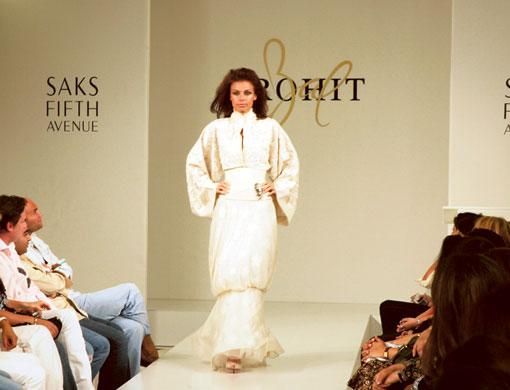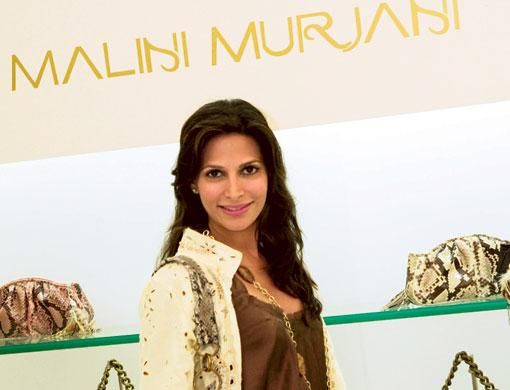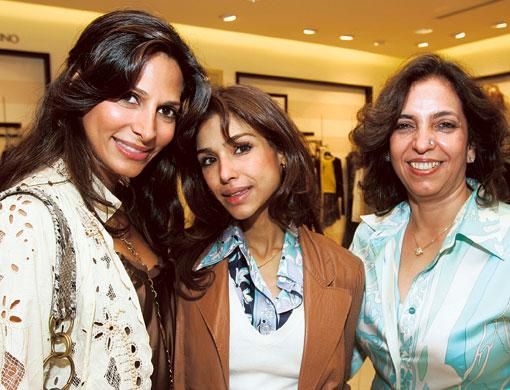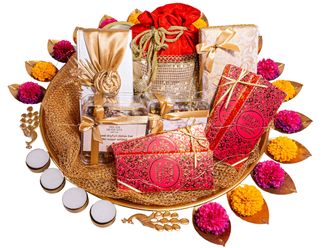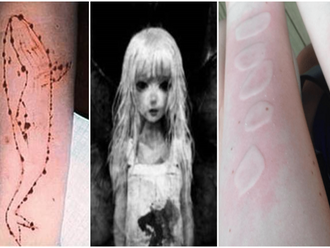Time magazine described him as ‘India's master of fabric and fantasy' and the Indian press loves to call him the “bad boy of fashion'. Outspoken, irreverent and incredibly talented, Rohit Bal is in the news as much for his flamboyant lifestyle as for his beautiful creations.
Awards
Known equally for his women's wear and menswear, the designer continually pushes the boundaries of fashion, setting new trends with every collection.
He has tantalised Indian fashionistas with his exquisite bridal wear and shocked them by sending his male models down the ramp in skirts.
He has won several awards for his work and his clientele includes the rich and famous in India as well as international celebrities such as Uma Thurman, Cindy Crawford, Pamela Anderson and Naomi Campbell.
Great fun
Rohit Bal's collections are now available in Dubai at Saks Fifth Avenue, located in BurJuman.
Tabloid! caught up with the blonde designer during his recent visit to the city for a showing of his spring/summer 2007 collection at the store.
True to his reputation, the designer was candid, irreverent and great fun. But behind the flamboyance and flippant repartee we saw a serious, thoughtful person and an artist who is passionate about his work.
Why has it taken you so long to come to Dubai?
Because I wanted to do it the right way. Rather than selling out of suitcases at small boutiques, I wanted to be in a place like Saks Fifth Avenue with my own 'store in store'.
Saks has treated me well and I am genuinely excited about the show windows they have done for me and the large space they have given me next to brands such as Dolce & Gabbana and Prada.
It is wonderful to know that my first collection here last season has been one of their best sellers. Now I will bring all my collections here and I will also do a bridal haute couture collection especially for Saks.
In the past I have worked with some boutiques here and am still with Kimaya in Dubai, but this is what I really wanted. I believe it is important that Indian designers should have the dignity and the confidence to change the perception that we are willing to sell out of suitcases.
Have you studied the Dubai market before coming here?
Have I ever studied any market? The market needs to study me. I have no clue about this market, except for the incredible response I saw today.
What is important to me is that Saks who have brought me here have faith in me.
What is the significance of the 'chakras' seen in your spring/summer 2007 collection?
Those circles are inspired by a Panama hat. Instead of jute I used velvet tape. Inspiration can come from anywhere, but it is important to not be limited by the idea but to let it grow from a cocoon to a larva and then a butterfly.
This entire collection is inspired by nacre or mother of pearl, but I deliberately did not use mother of pearl at all except in one pair of stockings.
Did you feel restricted by this limited palette of white and off-whites?
This collection is not about being restricted by whites but about my romance with this colour. This is my favourite colour and will always be because it is timeless and classic. If I had my way, I would only use whites in my creations and never feel the need to use any other colour.
Did you call your prêt line Balance because your clothes are about balancing the yin and yang?
My clothes are about gender bending, gender crossing and gender not caring and they do have a balance of yin and yang. But 'Balance' quite simply comes from my name Bal.
Tell us about the gold leaf printing in this collection.
During the reign of French king Louis the XVI gold leaf printing was extensively used on ceilings, furniture and garments. It later travelled to the Italian courts and then to the Mughal courts in India. The craft died out because it is too expensive.
I found craftsmen who knew this art and have revived it. It is fascinating to see how they beat nuggets of gold into thin gold leaf between sheets of leather or rubber. It is then put on the garments by heating and fusing.
Are you doing Madhur Bhandarkar's next film about the fashion world?
I have not said yes to him yet, but if the film is genuinely about fashion and not just the ugly side of the fashion world, I will do it. Because I think I can guide him in many ways about what is real and what is exaggerated and hopefully prevent him from doing an inaccurate or one-sided portrayal of Indian fashion.
And will you play yourself in the film?
Absolutely not … maybe … you never know.
How important is it for you to be accepted internationally?
The important thing is that if you are serious about your work, you do not want to be bound by geographical boundaries. You want to leap outside and reach everyone in the world.
Why have you not participated in New York, Paris, London or Milan Fashion Weeks?
Because I am not ready for it yet. Going there is expensive and doing one show does not help.
Besides, my intellect, mind and soul do not permit me to be in a place where I am not really wanted.
I will go to New York Fashion Week only when they insist that I must be there. And when I do go I will make sure that I make my presence felt for at least six seasons.
How important is it to have celebrity clients?
The fact that I have designed for Cindy Crawford or Pamela Anderson did not make any difference in their life or mine.
True success for a designer is not about one important person wearing your clothes, but many people who may not be well known buying your creations. If I walk into a mall in Dubai and see 20 people wearing my garments, that means much more to me than Cindy Crawford wearing my dress.
And I really mean that.
What do you love most about fashion?
Its unpredictibility. It is forever changing and you constantly need to think ahead. Designers are like time travellers — always thinking two seasons ahead.
Anything you want to say to fashion lovers in Dubai?
I make an incredibly hard and concerted effort to do what I do. And everything I do, I do for you.
Celebrity following Rohit Bal has designed for:
Uma Thurman.
Cindy Crawford.
Pamela Anderson.
Naomi Campbell.
Tennis star Anna Kournikova has walked down the ramp for his show.
Nacre — A hint of glint
Rohit Bal's spring/summer 2007 collection is inspired by the purity and ethereal nature of nacre or mother of pearl.
The feeling is serene with a monotone usage of creams, ivories and whites, expressing the purity of the soul in harmony with its surroundings.
He has used a variety of fabric techniques like pleating, layering, tonal embroideries, appliqué, laser cutting and velvet tape as well as basket weave embroidery and fine thread work.
The silhouettes range from bolero jackets, long coats and kaftans to fitted and ruffled skirts, sarees and sleek dresses.
With no crystals or sequins, the only hint of glint is in the form of antique metal wire in silver or gold called 'mokaish' and real gold leaf printing, an ancient art that Bal has revived.
Saks Fifth Avenue is currently taking orders from the catalogue and clients can choose from a palette of black, white, beige, ivory, misty rose and ice blue.
About the show
Dubai's fashionistas enjoyed a sneak preview of Indian designer Rohit Bal's spring/summer 2007 collection at a fashion show hosted by Saks Fifth Avenue, Dubai.
Bal is one of India's leading designers and has recently joined the elite list of international designer names retailing at the prestigious store located in BurJuman.
The collection, called Nacre, was quite a departure from Bal's usually flamboyant creations. The silhouettes ranged from fitted and flowing skirts, sleek dresses, and bolero jackets to long coats and kaftans, all in a mother of pearl inspired palette of beige, ivory and white. The men's garments included smart jackets and trousers in a similar palette.
Bal's cuts were impeccable and the styling sophisticated. The designer had used a variety of fabric techniques such as pleating, layering, tonal embroideries, and appliqué, completely avoiding crystals and sequins.
Also displayed on the ramp was the latest collection of bags by New York based Indian designer Malini Murjani. The collection called Urban Jungle included bags and belts in python and crocodile skin with fur, leather and jewel embellishments.
India in the limelight
The most important reason is that we have become quite indispensable to international fashion. India is no longer the flavour of the month or season; it is a part of the permanent cuisine of international fashion.
Today buyers are confident of our quality and reliability in terms of meeting delivery schedules because Indian fashion has grown from small workshop based enterprises to a mature industry.
The Fashion Design Council and its India Fashion Week has played an important role in changing international perceptions about us.
When we first began we had to beg buyers and fashion editors to attend. That gradually changed to coaxing and now we just have to ask. But the time is not far away when top buyers and editors will be begging for seats at our pret, couture and menswear weeks.
About the designer
Rohit Bal created his first line of traditional designer wear for men in 1990.
The designer has a deep interest in and knowledge of traditional Indian crafts and is known for the excellent workmanship of his creations.
In his latest collection he has revived the ancient art of gold leaf printing.
He has won many awards including designer of the year, best menswear designer and the prestigious ‘Shiromani' award for his contribution to Indian fashion.
Bal has appeared in films such as Monsoon Wedding and Love You Hamesha.


